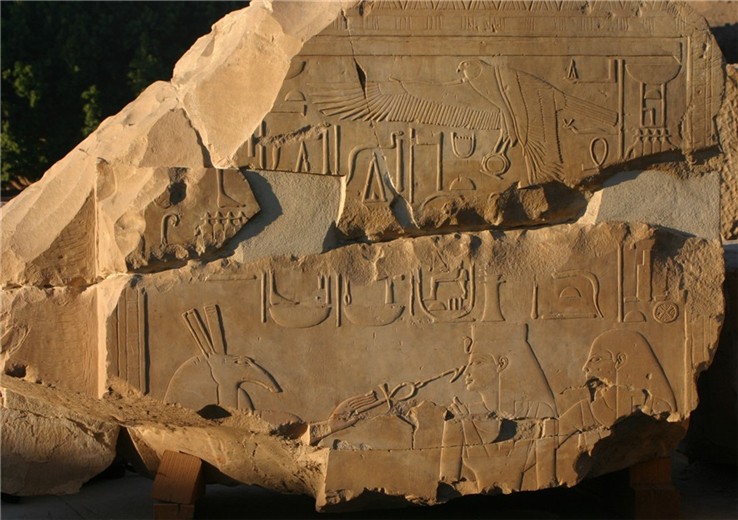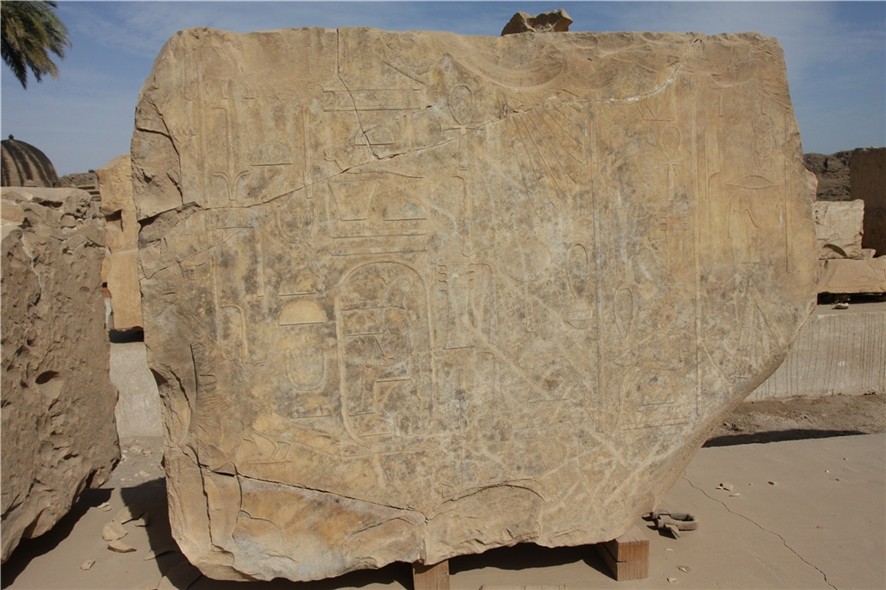|
Maat-ka-Ra Hatshepsut |
last update:
31.08.2008
|
From Royal Wife to Regent
| Aa-cheper-ka-Ra Thutmosis I was already middle-aged when
he, after a successful career, ascended to the throne which he held then for 13 to 15 years
(some remarks on the possible age of Thutmosis I, Hatshepsut und Thutmosis
II can also be find on the page History). If the
"King's Mother" Ahmose was the bodily sister of Thutmosis
I as her title "King's Sister" indicates, and if she
had married Thutmosis I at the occasion of his accession (see also: Family), then
Hatshepsut was most likely a child of approximately 12 years or a little
bit older, when she was married to her half-brother, Thutmosis II, and
became "Great Royal Wife". As the only surviving child of king
Thutmosis I and his chief queen, Ahmose, Hatshepsut as the "King's
[bodily] Daughter", "King's Sister" and a
"God's Wife [of Amun]"
endowed her half-brother with the full legitimation for his accession to
the throne.
|
|
Her half-brother might have had the same age, if Thutmosis I had married
his mother Mutnofret I like Ahmose at the beginning of his reign.
However, since it is generally assumed that he was a little older than
Hatshepsut, because Thutmosis I most likely had married Mutnofret some years
before Ahmose. Since Thutmosis II and Hatshepsut had a daughter,
the "Great King's Daughter" Neferu-Ra, the young king
obviously had at least reached his reproductive age.
|
|
This is further supported by the report of Ineni (which originates from the time of Thutmosis
III)
about the accession of Thutmosis II:
"The Horus [falcon] in the nest [ appeared on the throne ], the
King of Upper and Lower Egypt, Thutmosis II, [and] so he is King of the Black
Country (Egypt), so he controls the Red Country (desert). He took the Two
Lands in triumph."
|
|
Therefore, Thutmosis II (Aa-cheper-en-Ra) ascended to the throne as young Horus, as a "falcon in the nest".
Most likely both, Thutmosis II and Hatshepsut, were still so young that the
"Great Royal Wife" Ahmose exercised the regency. From the reign of Thutmosis
II little is reported
about military campaigns. Since already in the first regnal years his soldiers
put down victoriously a rebellion in Nubia (about which a report is given
on a triumphal stela at the road from Aswan to
Philae) this also speaks for the fact that the "young Horus" was still too
young to lead his soldiers by himself into the battle.
|
| From the years she shared with Thutmosis II there is no
indication that Hatshepsut strived for another position as the one that was traditionally assigned to
her.
|

| The block above which is today on show in the Open-Air-Museums
at Karnak shows the "God's Wife" Hatshepsut wearing a royal modius and the uraeus
on her head, given life and health by Set. The opposite side shows her husband, Thutmosis
II., welcomed by a god. Most likely, this block had been part of a dismantled
building of Thutmosis II. |

| Another block (see above; and the next one to the left), today
on show in the Open-Air-Museums at Karnak, shows the cartouche of Hatshepsut
containing her birth-name (@At-Spswt-xnmt-jmn) preceded with her full
titles as queen "Daughter of the King, God's Wife, Great Royal Wife". Again,
this block had been most likely part of a dismantled building of Thutmosis II. |
| It generally assumed that Thutmosis II had a weak constitution, possibly
he had never been the healthiest. In 1886, Maspero who unwrapped the mummy (see below)
which one regards as that of Thutmosis II described a badly injured body.
Most likely tomb robbers had broken off the right arm at the elbow and the entire left
arm of the mummy, additionally the right leg became cut off completely -
obviously with an axe.
|

| Mummy C of sarcophagi "C" which is assigned to Thutmosis
II (found 1881 in
DB 320); the label "C" refers to the localization in the "Cachette" of
DB 320 (Musée du Caire, CG 61066; JE 26212; Catalogue du Musée der Caire, plate
XXIII). |
|
The duration of the reign of Thutmosis II is given by Beckerath (1997)
with 12 - 14 years and by Grimm and Schoske (1999) with only 3 years - then
he was buried. However, recent investigation by the Egyptian Supreme Council of
Antiquities (Hawass, kmt 18-3, 2007) revealed that he died around an age of
40. |
| Up to now no tomb in the Valley of Kings could be assigned to
him with certainty but some evidence points to tomb KV42. The fact that KV42
is simple tomb in which a sarcophagi without inscriptions was found
indicates that the king died rather surprisingly and neither a suitable
tomb nor a sarcophagi of an appropriate high quality was available.
|
|
The successor of Thutmosis II was his son, Thutmosis III, who was born
by his second wife, Isis. How old Thutmosis III had been at the time his
father died and he ascended to the throne (in year 1479 B.C. due to Beckerath, 1997)
is not known. However he ruled for about 54 years - including the regency of
Hatshepsut - and his mummy is not that of a very old man. Thus, he was
most likely an infant and in each case not older than 10 years. According to an inscription
dated to year 42 of his reign he was 6 years old when he was chosen by an
oracle of Amun to become king. This inscription surely was an attempt to legitimize
his reign since no male heir to the throne came from the marriage of his father with
Hatshepsut and from his mother's side he was not of royal descent - however
the inscription can be used as a rough reference to his age at his accession.
|
|
Based on the aforementioned calculations about her age at her marriage and
about the duration of the reign of Thutmosis II Hatshepsut might have
been between 15 (after Grimm and Schoske) and 30 years (after Beckerath)
old at the time her husband died.
|
|
Since there is some evidence that Thutmosis I still reigned for at least 1 year after
her marriage with Thutmosis II Hatshepsut could have been quite 15 years - or only little older
- at least if her husband Thutmosis II had reigned only for about 3
years. Therefore, it is quite possible that her mother Ahmose exercised the regency for some time, before
Hatshepsut after the death of Ahmose - in agreement with the family tradition
of the Ahmosids and the Egyptian history (the exercise of the regency
for an under-age king is testified since the Old Kingdom) - exercised the regency
for the under-age Thutmosis III.
|
|


